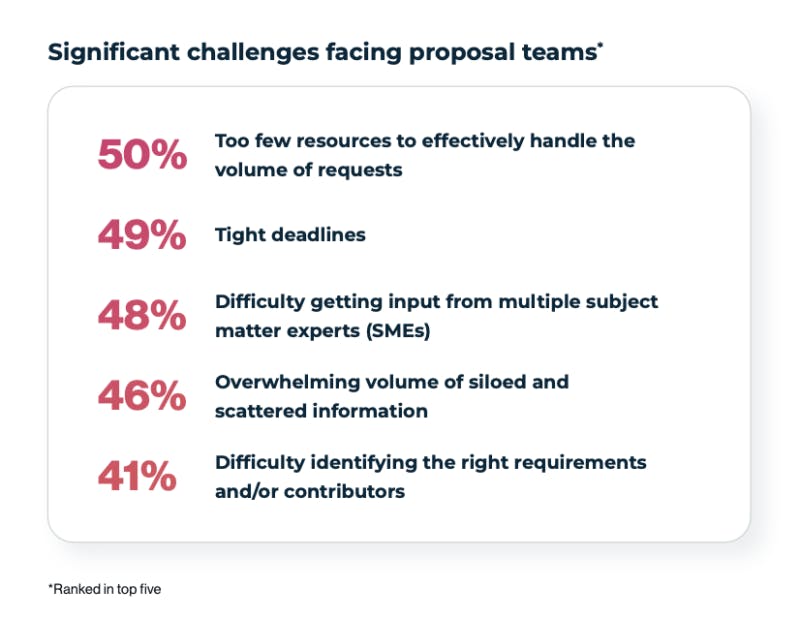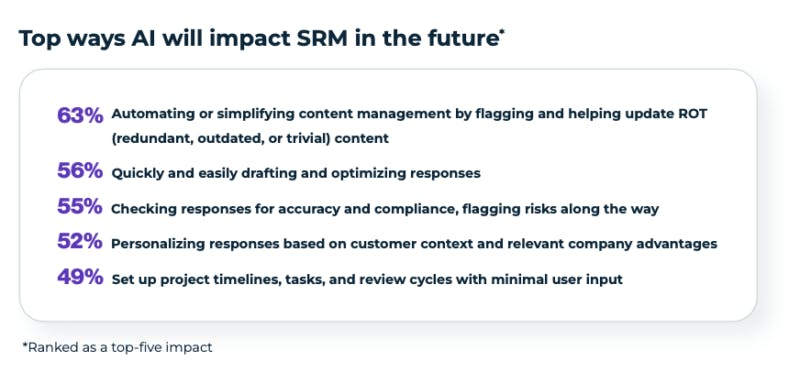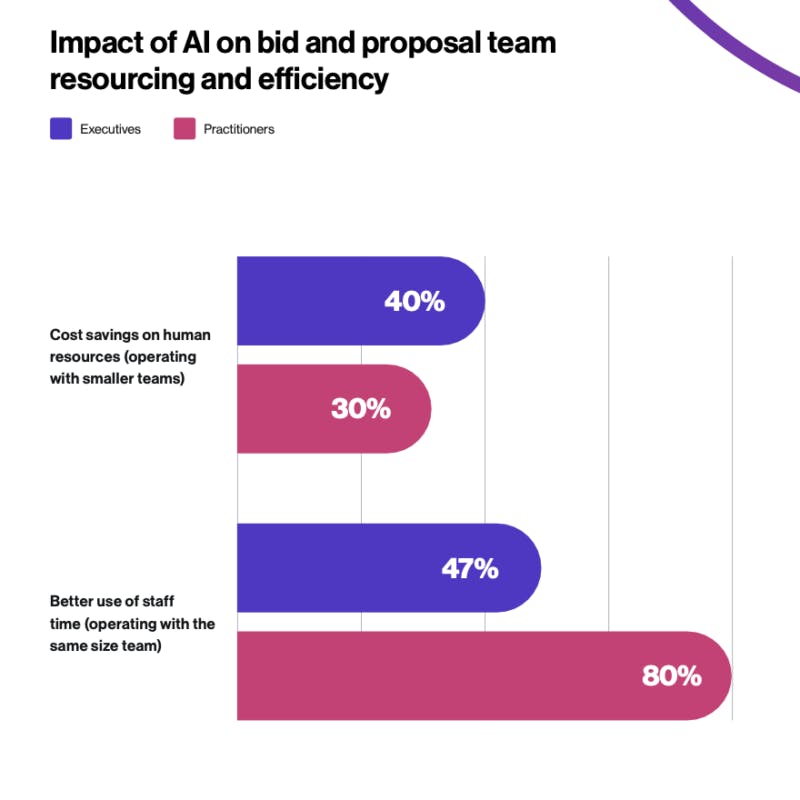The B2B pursuit cycle has never been more competitive. Buyers have tighter budgets and are also under increasing pressure to fulfill a wide range of internal and regulatory requirements. Buying committees have grown, which both lengthens sales cycles and adds to the requirements and questions asked throughout the sales cycle.
More requirements mean that RFPs and other information requests have become longer, more frequent, and more complex. Winning business calls for a thoughtful and bespoke approach to every RFP, proposal, and bid — all while protecting business interests.
Bid and proposal teams are already strained. With these increasing demands, the pressure is reaching a boiling point.
Generative AI (GenAI) has been a boon to response teams’ productivity. Its ability to help them craft responses faster than ever has enabled them to use their time to refine GenAI’s responses and get more bids out the door. But GenAI is just the tip of the iceberg.
AI’s deeper capabilities add strategic benefits that simple GenAI can’t touch. They can help you decide whether an opportunity is worth pursuing, choose ideal participants, keep the project on track, surface insights based on business intelligence, and tap into previously approved content to create bespoke responses based on customers’ priorities.
Responsive recently teamed up with the Association of Proposal Management Professionals (APMP) to survey 750 professionals around the world for The 2024 State of Strategic Response Management (SRM) Report. Among the findings, the report surfaced that companies embracing AI across the pursuit cycle — and going beyond GenAI for RFPs, proposals, and bids — are banking more wins. Organizations with revenue growth are 3X more likely to use AI-powered SRM platforms, according to the data.
Read on to see what exactly these companies are doing to gain a competitive edge with AI.
What is Strategic Response Management?
Strategic Response Management (SRM) refers to the people, practices, and technology that unlock organizational knowledge to achieve profitable growth.
Carrie Jordan, Global Director of Proposals serving Microsoft’s Proposal Center for Excellence, explains how SRM functions in practice:
SRM improves efficiency and boosts confidence in the proposal process. At Microsoft, the investment in an AI-powered SRM platform has streamlined access to a centralized knowledge base, allowing field teams to quickly find vetted, approved answers. This has resulted in substantial productivity gains, more efficient operations, and better resource allocation.
Bid and proposal teams sit at the epicenter of response management — they are the stewards of company knowledge and play a vital role in revenue generation. But bid and proposal teams can’t operate in a silo.
That’s where SRM comes in. Strategic Response Management democratizes knowledge across an organization and streamlines the cross-functional collaboration necessary to share company information with prospects and ultimately secure partnerships.
Key trends from the 2024 State of Strategic Response Management Report
What are bid and proposal teams experiencing “on the ground?” What are industry leaders’ perspectives?
Let’s take a look at some of the key trends in Strategic Response Management:
- 48% of company revenue, on average, is tied to RFPs, bids, tenders, and proposals
- 70% of respondents say revenue generated through bids, inquiries, and assessments has increased in the past year
- 90% say that bid and proposal teams are a direct and significant contributor to revenue
- 89% say that their organization is experimenting with AI, but leading organizations are going beyond GenAI for more than just writing

While the business impact of strategic response teams is evident, data from the report revealed that strategic response professionals are strained. There are many challenges facing proposal teams, including under-resourcing, tight deadlines, and an overwhelming volume of siloed and scattered information.
AI unlocks key efficiencies that can unburden strategic response teams. GenAI dramatically contributes to their efficiency when it comes to content production, but doesn’t solve for inefficiencies in other parts of the response process, like content and workflow management.
Broadening the use of AI for maximum impact
We know that companies at the forefront of AI adoption are seeing increased revenue. Yet, The 2024 State of Strategic Response Management Report found that fewer than one-third of companies have formally deployed any AI technology in their bid, proposal, and capture processes.
Nearly all respondents (96%) noted that strategic response processes require several key competencies, including:
- Aligning stakeholders
- Collaboration and organizational alignment
- A consistent voice and style
- Accuracy and compliance
- A single source of truth
- The ability to personalize responses
- The ability to track historical data
- Using key reports that measure the impact of responses
- Access to self-service automation
Robust SRM platforms go far beyond GenAI to address the end-to-end response process, going beyond text generation. This enables response teams to rapidly and efficiently assess every opportunity that comes in the door and create accurate and on-brand responses to any questionnaire that aligns with business goals.
GenAI in SRM
GenAI, made famous by chatbots such as ChatGPT and DALL-E, generates text, image, and other media types from human prompts. GenAI uses artificial intelligence to understand and respond to natural language. Some chatbots use GenAI technology. GenAI is trained on large language sets. Consumer-grade GenAI, such as ChatGPT, gets most of its training from the internet and customer data.
GenAI is currently the top way organizations use AI technology and is just one of an arsenal of AI tools used in SRM processes. Using input from an organization’s content library, GenAI assists through the entire writing process, from generating to editing and refining.
GenAI controversies
GenAI is not without its controversies and risks, which is particularly true with consumer-grade chatbots. According to the Responsive and APMP research, nearly three-fourths of organizations are concerned about potential privacy and IP risks, “hallucinations” (or fictional results), and risks from using content that’s not approved, compliant, or up-to-date.
Privacy
Consumer-grade GenAI is trained on public-facing content like the internet and human interactions with the tool.
Because public models are exposed to such large datasets, the possibilities for creative inspiration, problem-solving, and more are nearly limitless. However, consumer-grade models’ most significant strength is also its biggest weakness.
Any human interaction, whether the data entered is sensitive or not, may be used in its training. If your company manufactures widgets, for example, your proprietary blueprints could end up on someone’s personal computer or, worse, a competitor’s. It’s no wonder that nearly three-fourths of companies have privacy concerns regarding consumer-grade chatbots.
Depending on desired use cases, business-grade GenAI might initially be trained on public-facing content, but user interactions are not used for public training. All proprietary information is contained well within an organization’s virtual walls.
Hallucinations
Hallucinations are wrong answers that, at first glance, may seem correct. Neither consumer nor business GenAI is immune from hallucinations, which is just one of the reasons humans must remain in the loop.
That’s not to say that consumer-grade and business-grade GenAI carry the same risks of hallucinations.
Business-grade GenAI can still produce hallucinations, but they’re less common. Still, it could, for example, base its results on information from two years ago that matches all your criteria. So, all results need to be double-checked by humans.
Unapproved/out-of-date/non-compliant content
Using unapproved, out-of-date, or non-compliant content exposes organizations to legal and compliance risks, especially when the content is no longer accurate.
Like hallucinations, business-grade GenAI is less likely to uncover risky results than consumer-grade. More advanced AI can identify quality content; however, the best way to ensure approved, up-to-date, and compliant content is to keep it out of your content library, which means having a well-established and maintained content governance system.
For that, you’d have to go beyond GenAI.
Going beyond GenAI for proposals and bids
While GenAI enhances the SRM process with writing and translation, the sophisticated AI engine behind an SRM platform like Responsive automates the response process and amplifies potential use cases.

Go beyond GenAI for:
- Content governance — 63% of successful organizations surveyed in the 2024 State of Strategic Response Management Report believe AI will impact SRM through its ability to automate or simplify content management by flagging and helping update ROT (redundant, outdated, or trivial) content
- Fast, quality responses — 56% of organizations anticipate that AI will impact SRM by being able to quickly and easily draft and optimize responses with smart recommendations and intelligent automation
- Risk mitigation — 55% believe that checking responses for accuracy and compliance will impact the future
- More personalized responses — 52% believe that AI’s ability to create responses that are specifically tailored based on customer context and relevant company advantages will impact the future of SRM
- Workflow management — 49% believe that automated workflow management will impact SRM in the future. It already sets up project timelines, tasks, and review cycles with minimal user input
The best AI-led SRM platforms already have each of the above capabilities.
Will AI replace humans?

When the conversation around AI first heated up last year, many bid and proposal professionals feared that the technology would supplant them. The Responsive and APMP study reveals that AI — while transformational — is not a threat to anyone’s employment.
40% of leaders and 30% of practitioners believe AI will help strategic response teams operate with fewer employees. Headcount reduction seems to not be a major part of the equation, perhaps because many feel that AI will help fill in the gaps left by a global talent shortage with no end in sight.
47% of leaders and 80% of practitioners anticipate a better use of staff time. Of course, this includes taking a more strategic approach to each opportunity and generating higher-quality responses for higher win rates, revenue, and growth.
It’s clear from the sentiment surfaced in the research that most bid and proposal professionals no longer have fears surrounding job security. Instead, they’re excited that AI development will create an environment in which they can better thrive, delivering even more impact to the business.
AI strategies that yield results in Strategic Response Management
It’s worth noting once again that organizations experiencing revenue growth are 3X more likely to use an AI-powered SRM platform, according to the research.
As an example, Netsmart, a medical technology company, successfully implemented AI strategies with dramatic results. They now spend one-tenth the time they used to generate responses and submit 67% more proposals.
How did they do it? Andrew Mersman, Senior Director of Solution Consulting at Netsmart, described their strategy:
We knew it was crucial to build a solid foundation before diving into more advanced AI capabilities. Our initial focus was on refining our Strategic Response Management processes and ensuring our content was accurate and current. This step was essential because a strong foundation without cracks allows for smoother uptake of advanced features. Once we had that foundation in place, we could effectively expand our use of AI to draft and optimize the quality of our responses, which led to even more impactful and efficient responses. This approach helped us maintain efficiency and trust while gradually scaling up our use of AI capabilities.
Read the whole Netsmart AI case study here.
Steps to elevate your AI strategy
The 2024 State of Strategic Response Management Report found that 90% of companies say that response teams significantly contribute to revenue.
Changes in buying behavior are putting pressure on companies to grow efficiently, prompting bid, proposal, and capture teams to transform from back-office support to frontline revenue generators. AI is one piece of the puzzle, but it’s time for organizations to embrace a wholly new approach to Strategic Response Management.
Here are five pro tips to unlock growth:
- Elevate SRM management as a business-critical priority: SRM teams must earn a seat at the table where go-to-market strategies are set, alongside functions like sales, marketing, revenue operations, and customer success
- Advocate for the SRM team: Leadership should increase the visibility of their SRM team by articulating team value and clearly communicating the strategic role it plays and the revenue-driving processes and responsibilities
- Drive executive and cross-functional alignment: 85% of executives believe response teams are well-resourced. Practitioners disagree; only about half are satisfied with their roles. Facilitate two-way communication between senior management and strategic response teams.
- Choose a platform that will scale with your organization: Focus on business outcomes. Off-the-shelf GenAI provides only writing tools, while an SRM platform leverages AI for content management, intelligent workflow automation, and insights to scale effectively — in addition to purpose-built GenAI capabilities.
- Track activity metrics: Go beyond productivity metrics and focus on revenue growth, win rates, return on investment (ROI), compliance, and employee experience.
How leading companies are winning more
AI is the most transformative business tool to emerge in decades. The most successful organizations leverage AI in their SRM strategy to improve win rates, earn more revenue, and become more profitable while protecting company assets.
If you would like to learn more about how leading companies are winning more, grab a free copy of The 2024 State of Strategic Response Management Report.
You’ll dive deeper into a slate of topics, including:
- Responding to escalating buyer demands and stakes with an effective SRM strategy
- Demonstrating value as bid and proposal teams
- Pro tips and insights from industry luminaries
- Actionable strategies you can immediately employ to unlock faster growth

